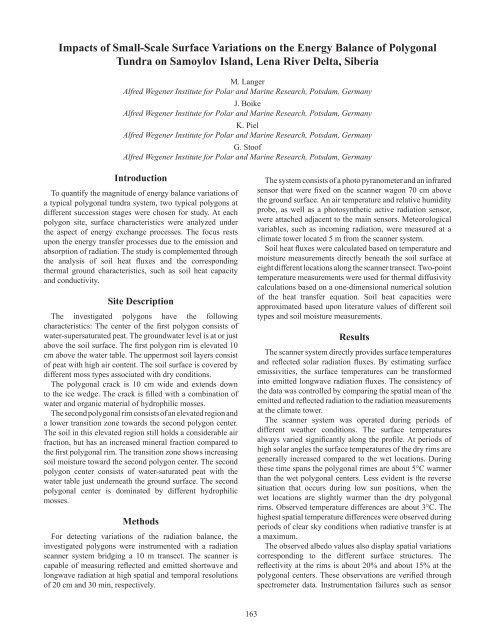Ninth International Conference on Permafrost ... - IARC Research
Ninth International Conference on Permafrost ... - IARC Research
Ninth International Conference on Permafrost ... - IARC Research
Create successful ePaper yourself
Turn your PDF publications into a flip-book with our unique Google optimized e-Paper software.
Impacts of Small-Scale Surface Variati<strong>on</strong>s <strong>on</strong> the Energy Balance of Polyg<strong>on</strong>alTundra <strong>on</strong> Samoylov Island, Lena River Delta, SiberiaM. LangerAlfred Wegener Institute for Polar and Marine <strong>Research</strong>, Potsdam, GermanyJ. BoikeAlfred Wegener Institute for Polar and Marine <strong>Research</strong>, Potsdam, GermanyK. PielAlfred Wegener Institute for Polar and Marine <strong>Research</strong>, Potsdam, GermanyG. StoofAlfred Wegener Institute for Polar and Marine <strong>Research</strong>, Potsdam, GermanyIntroducti<strong>on</strong>To quantify the magnitude of energy balance variati<strong>on</strong>s ofa typical polyg<strong>on</strong>al tundra system, two typical polyg<strong>on</strong>s atdifferent successi<strong>on</strong> stages were chosen for study. At eachpolyg<strong>on</strong> site, surface characteristics were analyzed underthe aspect of energy exchange processes. The focus restsup<strong>on</strong> the energy transfer processes due to the emissi<strong>on</strong> andabsorpti<strong>on</strong> of radiati<strong>on</strong>. The study is complemented throughthe analysis of soil heat fluxes and the corresp<strong>on</strong>dingthermal ground characteristics, such as soil heat capacityand c<strong>on</strong>ductivity.Site Descripti<strong>on</strong>The investigated polyg<strong>on</strong>s have the followingcharacteristics: The center of the first polyg<strong>on</strong> c<strong>on</strong>sists ofwater-supersaturated peat. The groundwater level is at or justabove the soil surface. The first polyg<strong>on</strong> rim is elevated 10cm above the water table. The uppermost soil layers c<strong>on</strong>sistof peat with high air c<strong>on</strong>tent. The soil surface is covered bydifferent moss types associated with dry c<strong>on</strong>diti<strong>on</strong>s.The polyg<strong>on</strong>al crack is 10 cm wide and extends downto the ice wedge. The crack is filled with a combinati<strong>on</strong> ofwater and organic material of hydrophilic mosses.The sec<strong>on</strong>d polyg<strong>on</strong>al rim c<strong>on</strong>sists of an elevated regi<strong>on</strong> anda lower transiti<strong>on</strong> z<strong>on</strong>e towards the sec<strong>on</strong>d polyg<strong>on</strong> center.The soil in this elevated regi<strong>on</strong> still holds a c<strong>on</strong>siderable airfracti<strong>on</strong>, but has an increased mineral fracti<strong>on</strong> compared tothe first polyg<strong>on</strong>al rim. The transiti<strong>on</strong> z<strong>on</strong>e shows increasingsoil moisture toward the sec<strong>on</strong>d polyg<strong>on</strong> center. The sec<strong>on</strong>dpolyg<strong>on</strong> center c<strong>on</strong>sists of water-saturated peat with thewater table just underneath the ground surface. The sec<strong>on</strong>dpolyg<strong>on</strong>al center is dominated by different hydrophilicmosses.MethodsFor detecting variati<strong>on</strong>s of the radiati<strong>on</strong> balance, theinvestigated polyg<strong>on</strong>s were instrumented with a radiati<strong>on</strong>scanner system bridging a 10 m transect. The scanner iscapable of measuring reflected and emitted shortwave andl<strong>on</strong>gwave radiati<strong>on</strong> at high spatial and temporal resoluti<strong>on</strong>sof 20 cm and 30 min, respectively.The system c<strong>on</strong>sists of a photo pyranometer and an infraredsensor that were fixed <strong>on</strong> the scanner wag<strong>on</strong> 70 cm abovethe ground surface. An air temperature and relative humidityprobe, as well as a photosynthetic active radiati<strong>on</strong> sensor,were attached adjacent to the main sensors. Meteorologicalvariables, such as incoming radiati<strong>on</strong>, were measured at aclimate tower located 5 m from the scanner system.Soil heat fluxes were calculated based <strong>on</strong> temperature andmoisture measurements directly beneath the soil surface ateight different locati<strong>on</strong>s al<strong>on</strong>g the scanner transect. Two-pointtemperature measurements were used for thermal diffusivitycalculati<strong>on</strong>s based <strong>on</strong> a <strong>on</strong>e-dimensi<strong>on</strong>al numerical soluti<strong>on</strong>of the heat transfer equati<strong>on</strong>. Soil heat capacities wereapproximated based up<strong>on</strong> literature values of different soiltypes and soil moisture measurements.ResultsThe scanner system directly provides surface temperaturesand reflected solar radiati<strong>on</strong> fluxes. By estimating surfaceemissivities, the surface temperatures can be transformedinto emitted l<strong>on</strong>gwave radiati<strong>on</strong> fluxes. The c<strong>on</strong>sistency ofthe data was c<strong>on</strong>trolled by comparing the spatial mean of theemitted and reflected radiati<strong>on</strong> to the radiati<strong>on</strong> measurementsat the climate tower.The scanner system was operated during periods ofdifferent weather c<strong>on</strong>diti<strong>on</strong>s. The surface temperaturesalways varied significantly al<strong>on</strong>g the profile. At periods ofhigh solar angles the surface temperatures of the dry rims aregenerally increased compared to the wet locati<strong>on</strong>s. Duringthese time spans the polyg<strong>on</strong>al rimes are about 5°C warmerthan the wet polyg<strong>on</strong>al centers. Less evident is the reversesituati<strong>on</strong> that occurs during low sun positi<strong>on</strong>s, when thewet locati<strong>on</strong>s are slightly warmer than the dry polyg<strong>on</strong>alrims. Observed temperature differences are about 3°C. Thehighest spatial temperature differences were observed duringperiods of clear sky c<strong>on</strong>diti<strong>on</strong>s when radiative transfer is ata maximum.The observed albedo values also display spatial variati<strong>on</strong>scorresp<strong>on</strong>ding to the different surface structures. Thereflectivity at the rims is about 20% and about 15% at thepolyg<strong>on</strong>al centers. These observati<strong>on</strong>s are verified throughspectrometer data. Instrumentati<strong>on</strong> failures such as sensor163
















